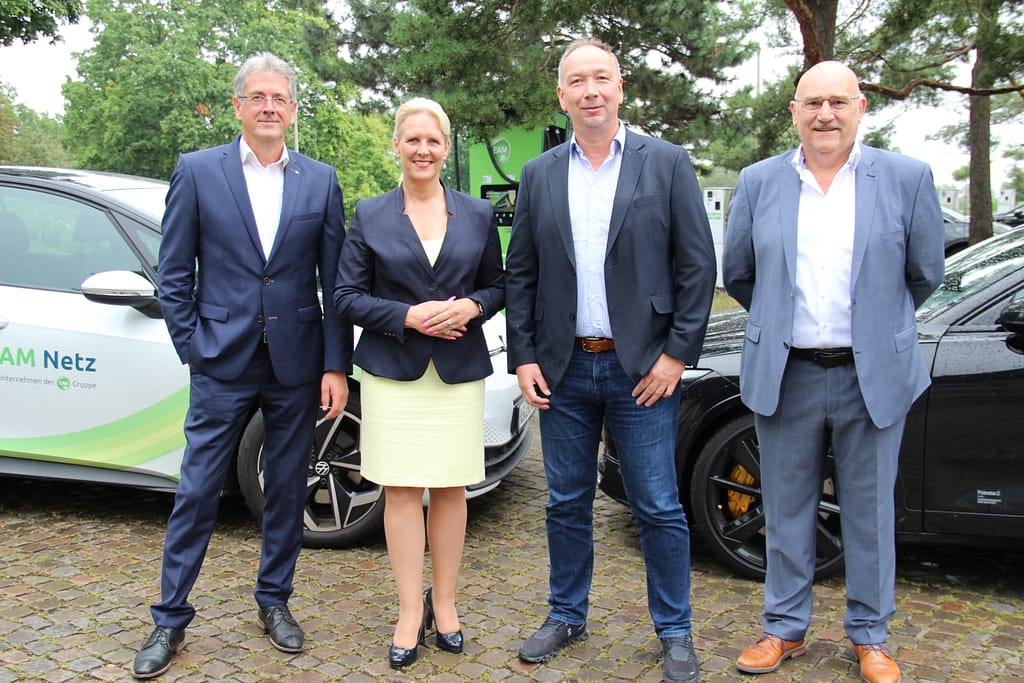
From left to right: Raymon Deblitz (Managing Director T&B Consulting), Dr. Diana Warnecke (Project Manager and Strategy Consultant), Sven Nuhn (Managing Director EAM Natur Energie), and Georg Schmitt (Managing Director Grid & Co. GmbH
Source: EAM Natur Energie GmbH
Proof of Concept successful: Pioneering results for bidirectional charging and digital services
Hanover | Kassel, June 4, 2025 – After intensive development work and extensive testing, the Proof of Concept (PoC) of the Germany pilot project for bidirectional charging has been successfully completed. As part of the project, the initiators EAM, T&B Consulting, and Grid&Co designed, configured, and tested the entire infrastructure – including OEMs (Original Equipment Manufacturers), wallboxes, energy management systems (EMS), charging point management systems (CPMS), as well as the associated protocols.
With the successful completion of the PoC for bidirectional charging (V2B, V2H, V2G), the project partners demonstrated the technical feasibility of bidirectional charging and laid the foundation for new business models and digital services in this field. The following four results highlight the success of the project phase:
Proof of Technical Feasibility:
Through the seamless integration and successful testing of all components, the project partners demonstrated that bidirectional charging is a viable technology, both technically and practically. The integration of electric vehicles as flexible energy resources was confirmed to be functional and scalable. The Polestar 3 and Volkswagen ID.3 successfully passed testing as operational components in conjunction with a bidirectional charging wallbox from Ambibox, a functional EMS (Energy Management System), and the software intelligence of Grid & Co.
New Business Models for Digital Services:
Within the project, the partners defined new business models that incorporate digital services around bidirectional charging. These innovative models include, among others, fleet-based charging to buffer short-term peak loads and community-based V2G models. They open up new business approaches that optimize the flow of electricity between electric vehicles and the local grid, providing a forward-looking solution for the energy transition.
Definition of Supporting Control Models:
To support the new business models, the project partners developed comprehensive control models that ensure the safe and efficient use of the infrastructure. These frameworks guarantee that the systems operate reliably and stably under varying conditions and enable high integration of electric vehicles into the power grid.
Analysis of Advanced Services:
The project partners also examined advanced services that extend the potential of bidirectional charging. These include, among others, Virtual Power Plants (VPPs), cybersecurity solutions, and roaming approaches for efficient use and billing of charging infrastructure. These advanced services could significantly drive the long-term scalability and economic viability of V2X technologies.
Looking to the Future:
With the successful completion of the PoC project, the door is now wide open for broader adoption of bidirectional technologies. The insights gained provide the foundation for the development of scalable business models and the introduction of market-ready solutions. The project thus represents an important step toward a more sustainable and flexible energy supply.
„With the successful completion of the Proof of Concept, we have shown that bidirectional charging is no longer just a future scenario, but works in practice. For us as a regional energy provider, this technology offers the opportunity to avoid peak loads in the power grid while simultaneously integrating more renewable energy into the system. In the future, the technology will play an important role in the flexible use of power grids. We see it as a key component for actively involving our customers in the energy transition while also providing them with economic benefits,“ explains Sven Nuhn, Managing Director of EAM Natur Energie.
„The successful completion of the PoC for bidirectional charging impressively demonstrates the potential of grid-supportive integration of electric vehicles,“ says Raymon Deblitz, Managing Director at T&B. „As an energy company, we see a real opportunity in this technology to proactively stabilize power grids – for example, by providing flexibility for balancing energy markets or relieving local distribution networks. The PoC thus provides an important foundation for scalable applications in real grid operations.“
According to Dr. Diana Warnecke, who led the bidirectional PoC in her previous role as Project Manager at NTT DATA DACH, the project’s completion marked a decisive step toward a more flexible and decentralized energy system. During the project, she emphasized bidirectional charging as a central innovation driver that connects mobility and energy in a novel way and enables new business models along the entire energy value chain. In addition, the technology strengthens both supply security and customer benefits, actively contributing to the energy transition.

No responses yet